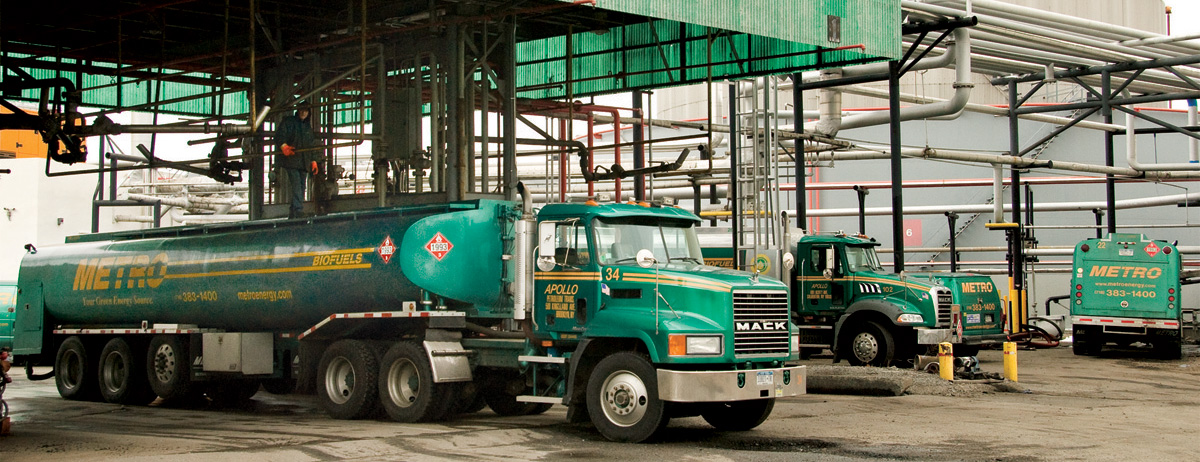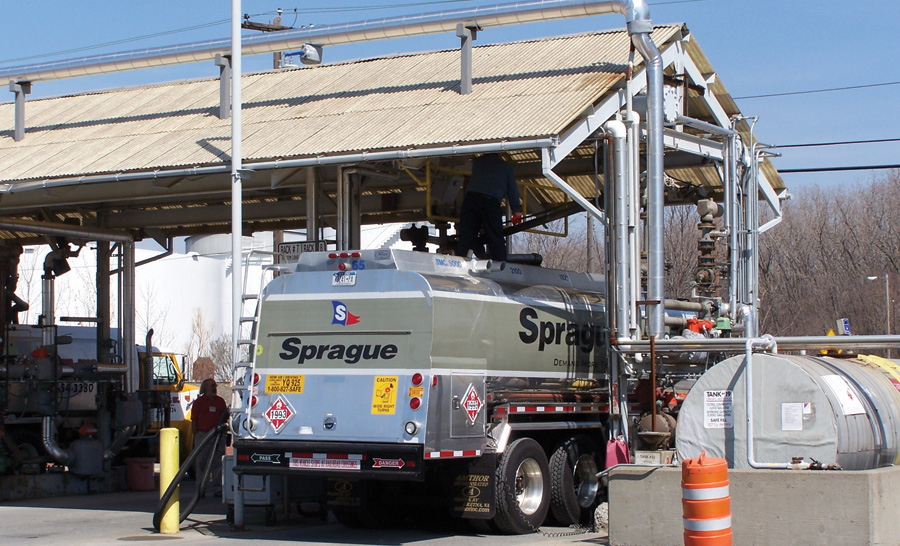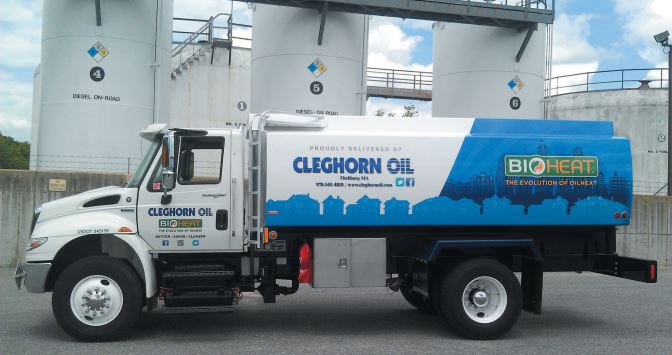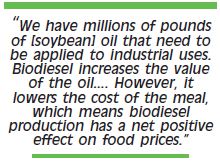In the perpetual search for the next great renewable heating fuel, there remains only one that has a sufficient supply and distribution network in place, can be used in (and is, in fact, better for) existing heating oil equipment, can beat natural gas on environmental benefits, and has the marketing support of both The National Oilheat Research Alliance (NORA) and the state oil heat associations.
Yet, if you asked the average homeowner about their thoughts on Bioheat® fuel, you’d probably get little more than a blank stare in return. If the heating oil industry is going to survive in the 21st century, that scenario needs to change.
Lack of consumer knowledge is one of the biggest obstacles facing heating oil dealers today. The common belief that every dealer is essentially selling the same product means that many heating oil consumers are making decisions based exclusively on price. In response, the industry has largely conformed to that narrative, regarding fuel as a mere commodity—and marketing it as such.
While there’s no denying that marketing low price to a price-driven consumer base is an effective way to attract new customers, it’s no way to retain them. A dealer who wins a customer on dollar-per-gallon today is the dealer who will lose a customer on dollar-per-gallon tomorrow.
Brand loyalty is built upon differentiation and oil heat dealers have never had a more marketable product with which to differentiate themselves than Bioheat®. With the transition to Ultra Low Sulfur Heating Oil (ULSHO), and with B6-B20 ® blends included in ASTM D396 heating oil standards, oil heat dealers can now offer the safest and least carbon-intensive renewable fuel on the market—at a time when consumer demand for such a product is at an all-time high. At a cost competitive rate, heating oil customers can have a far cleaner, more efficient and higher performing product that will benefit the environment, their health, and their wallet.
Just a few years ago, an oil heat consumer research study by Warm Thoughts Communications found that nearly 50% of younger-aged homeowners interested in converting from oil heat to natural gas said that they would be less likely to do so if Bioheat® was available to them.

Educating the consumer
Bioheat® can only serve as an effective differentiator if consumers are educated on the topic. Raising consumer awareness via website, social media, marketing brochures, traditional advertising, customer newsletters and through personal interaction are all good ways to market fuel quality. However, the most effective marketing strategy is to provide evidence that the fuel actually works. Showing customers their fuel filters, tracking efficiency measures and recording drops in maintenance issues goes a long way towards debunking the tired “oil is oil” narrative, strengthening your value proposition and building loyalty not only to your brand, but to our industry. ICM
For more information on fuel quality, maintenance, additives, or treatment solutions, contact Paul Nazzaro at 978-258-8360 x301 or paulsr@yourfuelsolution.com.
In his book, Built to Last, management expert Jim Collins examines how it is that some companies manage to achieve and sustain excellence across decades, and even centuries, through multiple generations of leaders. By studying companies that have prospered over the long term, Collins and his team were able to identify timeless fundamentals that enable organizations to endure and thrive through constantly changing times. One fundamental that I find particularly resonant is the concept of “dynamic duality.” Collins explains:
“On the one hand, enduring organizations have a set of timeless core values and purpose that remain constant over time. On the other hand, they have a relentless drive for progress—change, improvement, innovation, and renewal. Great organizations keep clear the difference between their core values (which never change), and operating strategies and cultural practices (which endlessly adapt to a changing world).”
Most fuel dealers have the first part down pat. Their core values—service, dependability, honesty—have informed their businesses from the start. It’s the second part of the equation—the willingness and ability to adapt—that separates fuel dealers who will endure from those who will flicker out.
Make no mistake about it: For those who sell or consume fuel, there have never been more variables around which to adapt. Growing competition from natural gas and renewables aside, with the policy directives currently being placed on refiners and OEMs, today’s ultra-low-sulfur diesel fuels are proving increasingly problematic for heating oil customers and diesel fleets alike.
While Ultra Low-Sulfur Diesel is certainly a cleaner burning fuel—especially when blended with biodiesel—it is not a fix-all for every common fuel problem, nor does it come without its own set of operability concerns.
Because sulfur acts as a natural lubricant, ULSD is “dryer” than traditional diesel, meaning that its lower in lubricity, more prone to holding entrained water, and more susceptible to water and microbial contamination—the precursors to corrosion.
The refining process used to remove sulfur also removes oxygen, nitrogen and other functional elements, yielding a fuel that is more paraffinic, or waxy, to the detriment of its cold flow operability, and less stable in storage. ULSD is also more solvent, or liable to loosen filter-plugging deposits in tanks. Lastly, just because ULSD is “cleaner” than traditional diesel, it is not any less corrosive to tanks, pipes and system components if left untreated.
For diesel fleets, ULSD has plagued High Pressure Fuel Injection systems with a number of issues, including injector failures, filter plugging, loss of power and reduced fuel economy. More recently, fuel injection systems with exhaust gas recirculation (EGR) and diesel particulate filters (DPF) are increasingly more problematic.
The point is, businesses that tout premium service but continue to sell generic fuels that meet minimum ASTM specifications are simply not built to last in today’s rapidly evolving market. In fact, they’ll be the first to fall. Now more than ever, quality of fuel is every bit as important as quality of service.
A fuel maintenance program that combines today’s advanced additive technology with sound storage, transportation and general housekeeping practices can prevent unnecessary fuel problems and optimize performance to create a premium product tailored to meet the needs of customers. Cold flow additives prevent fuel gelling to keep diesel engines and heating systems running smoothly through the winter. Detergents keep tanks and injector systems clean. Combustion catalysts increase fuel efficiency and decrease emissions. Corrosion inhibitors protect tank linings. Biocides control microbial contamination. Water control treatments prevent fuel degradation and other water-related issues. Biodiesel (though not an additive) is a cleaner burning, renewable fuel that can be blended with traditional diesel at rates that beat natural gas on environmental benefits. This is the kind of information that fuel dealers should be sharing with their customers. For a few cents more per gallon, they can have a cleaner, higher performing product that will quickly pay for itself in the form of restored efficiency, reduced maintenance and less down time.
Offering a premium product can only serve as a differentiator if consumers are educated on the subject. Raising consumer awareness via website, social media, marketing brochures, traditional advertising, customer newsletters and through personal interaction are all good ways to market fuel quality. However, the most effective marketing strategy is to provide evidence that the enhanced fuel actually works. Showing customers their fuel filters, tracking efficiency measures, and recording drops in maintenance issues goes a long way towards debunking the tired “oil is oil” narrative, strengthening your value proposition, and building a business that won’t just last, but thrive.
For more information on fuel quality, maintenance, additives, or treatment solutions, contact Paul Nazzaro at 978-258-8360 x301 or paulsr@yourfuelsolution.com.

Paul Nazzaro is Principal of the Nazzaro Group and frequently represents the National Biodiesel Board. Jacqueline Devine crafted the proposed legislation when she was 13.
809H A BILL TO REDUCE EMISSIONS FROM FACTORIES ACROSS AMERICA BY SWITCHING TO BIODIESELFactories in America are one of the leading causes of global warming. They produce 40% of the pollution in the United States. Each year, over 20,000 factories in the U.S. produce four billion pounds of toxic chemicals that are admitted into the atmosphere. […] Factory emissions contribute to these gases in the atmosphere and further the harmful effects of pollution. Alternative fuels, such as Biodiesel, can be created out of soybeans, corn, algae, and other renewable resources. Biodiesel burns cleaner than regular conventional heating oil, and is better for the environment. If factories switch their oil system from a fossil fuel to Biofuel, then the rate of gases emitted will not only decrease, but also the Biodiesel will better the environment due to the fact that the oil is renewable.BE IT ENACTED by the Senate and House of Representatives of the United States of America in Congress assembled, that:Section 1: Large factories across the U.S. shall switch from the use of conventional oil to Biodiesel. Large factories shall be classified as a building producing extensive amounts of products that are purchased by many Americans.Section 2: The money needed to support the transfer to Biodiesel shall be funded by the recent tax incentives passed in regards to alternative energy.
Bioheat says “Thanks” by awarding $30,000 to Charities that also “warm” NYC
In December 2012, New York City launched its mandate for traditional home heating oil to be blended with 2 percent biodiesel, also known as Bioheat Fuel. Already the nation’s largest municipal user of biodiesel, NYC takes the lead in sustainable heating, reducing the city’s carbon footprint and replacing up to 20 million gallons of petroleum annually. The Bioheat bill advances one of the major goals of the city’s sustainability agenda, PlaNYC, committed to having the best air quality of any major city in the nation by the year 2030.
As a thank you to the city, Bioheat recently launched their NYC Proud 2B2 Renewable Warmup campaign. This campaign will award three out of eight nominated charities a grant in the amounts of $15,000, $10,000 or $5,000. Between January 28th and February 17th, 2013, NYC residents are asked to go to BioheatOnline.com to vote for the charity they feel best helps “warm” NYC ..
“Our objective with the NYC Bioheat Proud 2B2 Renewable Warmup campaign is twofold. We wanted to give back to the NYC community in more need than ever after the impact of Hurricane Sandy. We also wanted to do it in a way that would increase the awareness of Bioheat Fuel’s benefits and the impact it can have on the environment to other regions,” said Paul Nazzaro, President of Advanced Fuel Solutions and advocate for the National Biodiesel Board’s Bioheat education program.
New York City’s mandate replaces 20 million gallons of petroleum annually with a local, renewable resource that’s also cleaner burning. It’s the carbon equivalent of taking 30,000 cars off the road in New York City. According to a National Biodiesel Board study, it has the economic impact of creating 780+ biodiesel production jobs in the region and $42 million in household income.
Nazzaro adds, “It is important that the progress continues. 80% of oil heat households in the United States are located in the Northeast region and purchase about 5.1 billion gallons of heating oil in a year. If the entire Northeast region switched to Bioheat Fuel, we would replace 100+ million gallons of oil with a local, greener resource each year.”
“The New York Oil Heat Association (NYOHA) has long fought for a new standard in heating oil,” said the association’s CEO John Maniscalco. “The heating oil of the past will soon be gone. Instead, Bioheat Fuel will become the standard in home heating sustainability. NYC should be proud to lead the effort and proud ‘2B’ staying warm.”
Bioheat Online is a resource for consumers and oil heat dealers brought to you by the National Biodiesel Board and Advanced Fuel Solutions (AFS), a leading additive supplier and market consultant in the fuel industry for 13+ years. Consumers can go to the following Web site for the contact information to write their Senator to support a biodiesel tax incentive for 2013: http://www.senate.gov/general/contact_information/senators_cfm.cfm/.
==========================================
As of January 1, 2013, the Independent Connecticut Petroleum Association has become CEMA, the Connecticut Energy Marketers Association. More information is available at the association’s new website, http://www.ctema.com.
 That’s not a typo above. The association added the “t” in the website extension because “cema” was not available. In addition, four e-mail addresses have changed:
That’s not a typo above. The association added the “t” in the website extension because “cema” was not available. In addition, four e-mail addresses have changed:
Gene Guilford is gene@ctema.com
Chris Herb is chris@ctema.com
David Chu is chu@ctema.com
Phyllis Stickler is books@ctema.com
The association’s ICPA Education Foundation Technical Education Center, known as ITEC, remains the same for the time being until its name is changed, and its website remains www.icpatec.com. Joe Buchas is joe@icpa.org
The final question of a recent Bioheat® fuel dealer survey funded by the National Biodiesel Board asked heating oil fuel dealers, “Everything being equal, would you prefer Bioheat fuel as your home heating oil product, or are you satisfied with generic home heating oil high or ultra-low-sulfur? “
 The response most checked off was, “Today’s heating oil is fine with me.” Yes, 50 percent of fuel dealers taking time to participate responded they are comfortable delivering plain old heating oil. The remaining half responded, “I would like to transition to Bioheat fuel,” followed by, “I would sell both regular oil and Bioheat fuel.”
The response most checked off was, “Today’s heating oil is fine with me.” Yes, 50 percent of fuel dealers taking time to participate responded they are comfortable delivering plain old heating oil. The remaining half responded, “I would like to transition to Bioheat fuel,” followed by, “I would sell both regular oil and Bioheat fuel.”
Recently, I attended the National Association of Convenience Stores conference and was intrigued by their keynote speaker, Peter Sheahan. Sheahan is globally recognized as a leading expert in workforce trends and generational change. He stated, “Customers feel a product is cheap at the price, not when they pay the lowest possible price, but when they feel they received great value and a good deal on all measures, including price.”
My take away, how could an Oilheat customer feel good about the price of oil when very little is being done to convey what the value of this product really is? Many dealers believe that ultra-low sulfur heating oil is the logical and only next step for the industry. Truth be told, regardless of the sulfur level in the heating oil you deliver, it remains a carbon based fuel. The lower sulfur story is a better one, but not better than the story waiting to be told when you combine ultra-low sulfur heating oil blended with biodiesel, a/k/a Bioheat® fuel. The truth of the matter: you will never be clean enough or cheap enough unless you start creating a story around the product which you sell. Stop discounting your offering by referencing it as a commodity. The commodity ends when your delivery truck leaves the rack and heads to your customer’s home.
The message to be taken from Sheahan is clear; you need to tell your customers what Bioheat is and what value they will take away as your customer. Many dealers taking this survey said that conventional heating oil is not competitive against other fuels, such as gas, propane or wood pellets (78%), which was no surprise. Responders then went on to say they thought Bioheat fuel was about the same as other fuels, such as gas, propane and wood pellets (72%). Well, if these responses reveal anything, they suggest dealers would have a better chance of succeeding if they presented the Bioheat proposition to their customers simply because of the marketing advantages associated with the renewable component, not the carbon component.
Other highlights of the survey which caught my attention were that 71% of those polled responded they never used the sales and marketing tools made available through the National Biodiesel Board. When asked if they had ever visited www.bioheatonline.com, 73% responded, “No”; however, of the 27% that did visit the site, 97% found the website informative and valuable. The survey also revealed only 23% had applied to become a registered Bioheat fuel dealer, and 84% said their customers never requested the fuel. On the subject of Bioheat and its technical performance, 49% of those polled felt the fuel had noted challenges; they referenced blending issues, gelling, phase separation and general quality concerns. As a long time booster of Bioheat, these observations are frustrating and necessitate reflection to determine the best and most direct way to alleviate those individuals’ fears. More important, will the industry ever join together to declare that they are interested in transitioning to ULSHO with biodiesel?
During the past decade, millions of dollars have been invested by the National Biodiesel Board to help restore oil heat to its former level of prominence within the home heating marketplace. Extensive training for dealers, leaders and their customers have been administered and we still have 50 percent of dealers content with the state of the industry and not eager to advance their companies’ business towards Bioheat. Worse, only a handfull of state Oilheat leaders have stepped in to lead this transition to a cleaner burning fuel.
On a positive note, 72% of those participating did state that Bioheat was available at a terminal from which they lifted their heating oil, so they couldn’t say Bioheat was not available. Close to 50% did think Bioheat was the logical next step to advance the industry. Further, half preferred Bioheat and would sell it—but when? Action creates clarity and at some point, you have to stop thinking, stop planning and just do something, anything to get traction in your business. You can be one of the 50% who said, “Today’s heating oil is fine,” but you know it’s not. You know that fuel quality is compromised; its price to value is not marketable and you are quickly losing your customers’ confidence.
With this, many continue to buy and sell generic heating oil, accepting this as the norm and interestingly, expecting a different outcome. Without taking action, the water cooler chatter which one hears every day will remain the same: “I hope we have a cold winter”, “I hope crude settles lower and I really hope that gas conversions slow down.” These are notable concerns which make for a great wish list, but do absolutely nothing to put you and your organization on the proactive track to success. Your decision to take part in this evolution needs to start today. That’s because the resources the industry has had access to for the past several years to promote Bioheat are now beginning to become limited.
If we are to continue our effort to transition the industry, it will take a collective effort from fuel dealers, equipment manufacturers and industry leaders, all of whom have skin in the game. If this were five years ago, the use of diplomacy to encourage you to begin your transition would be relied upon—unfortunately, it’s not—and time is of the essence.
“If not Bioheat, then what?” If you are interested in becoming part of the 50% wanting to embrace change and would like to access sales and marketing training as well technical support, please feel free to reach out for immediate assistance. In the upcoming weeks, you will be witness to an aggressive consumer television marketing campaign designed to educate your customers about Bioheat. Will you be ready to answer their questions when your phone rings? There are only a few responses to this question: “Yes”, “No” or, “I like things just the way they are.”
For more information, contact Paul Nazzaro,
978-258-8360 x 301 or write paulsr@yourfuelsolution.com and please visit www.bioheatonline.com.
 This time, the start of October and the oilheat season brings a landmark change. In New York City, the biggest city in the nation, a new Bioheat® fuel requirement takes root. For oilheat dealers, this presents a major opportunity for building long-term customer satisfaction—and retention. This is clearly an evolution much needed.
This time, the start of October and the oilheat season brings a landmark change. In New York City, the biggest city in the nation, a new Bioheat® fuel requirement takes root. For oilheat dealers, this presents a major opportunity for building long-term customer satisfaction—and retention. This is clearly an evolution much needed.
The people who work and live in New York City can now take comfort in knowing the oilheat that heats their businesses and homes is the cleanest in the nation, and quite possibly the world. Starting October 1, every gallon of oilheat in the city must contain at least two percent biodiesel. The blend is known as Bioheat® fuel.
The law comes as the result of 2010 legislation, when Mayor Michael Bloomberg signed an air quality bill that included the Bioheat provision for heating homes and buildings. A recently enacted New York State bill also required a switch to Ultra Low Sulfur Heating Oil, which took place in July. City Councilman James F. Gennaro sponsored the Bioheat legislation, with the effort supported by John Maniscalco, CEO of the New York Oil Heating Association, as well as the National Biodiesel Board.
Biodiesel is a renewable fuel made from agricultural byproducts and co-products such as soybean oil, and other fats and oils, including at least one abundant resource in New York City: recycled restaurant grease. It is the only domestically produced, commercially available advanced biofuel in the U.S., and supports 39,000 American jobs.
The mandate will replace 20 million gallons of petroleum annually with renewable, sustainable, domestically produced biodiesel. Not only does that replace foreign oil, it supports green collar jobs and green economic growth in the New York City area as a result. Those benefits are real and tangible, and are something oilheat dealers and customers alike can feel good about.
The City Council passed the bill unanimously—a vote of 45-0. That kind of universal support is rare, and underscores that the city is moving in the right direction, according to NYOHA’s Maniscalco. A long-time Bioheat fuel visionary himself, he championed the unprecedented municipal legislation, recognizing the powerful opportunity that Bioheat has in keeping the oilheat industry viable.

“Metro is proud to have been a part of a local biodiesel movement whose aim is to create a cleaner, more renewable and more energy independent future right here in New York City. We don’t plan to stop at a B2 mandate and call it a day. We are excited about getting more and more customers on B5, B10 and B20 where the benefits become even greater for us and future generations.” —Gene Pullo, President of Metro Terminals, the Brooklyn-based energy company that is in the finals stages of building the largest biodiesel processing facility in the United States.

“Sprague has been supplying biodiesel and Bioheat fuel to our wholesalers for years, as we long ago recognized the superior operability benefits of biodiesel within heating systems. Customers appreciate the reduced maintenance and extended equipment life resulting from the cleaner burning fuel. We hope New York City’s efforts will encourage other cities and municipalities to consider the benefits of Bioheat for the environment as well as for its enhanced performance.” —Steven J. Levy, Managing Director of Sprague Operating Resources LLC and National Biodiesel Board (NBB) Governing Board Member

“I’ve never seen a more beautiful truck,” said Ryan Roy, the director of operations for Massachusetts-based Cleghorn Oil. “This is the crown jewel, the showpiece of our fleet. I almost want to put it on a pedestal and keep it as a trophy. People see it and say, ‘Wow, I’ve never seen anything like that.’”
Cleghorn, which changed its oilheat line exclusively to Bioheat this year, won the wrap at the New England Bioheat Symposium in Boston in March. The application of the wrap was paid for thanks to funding from the Nebraska Soybean board and the United Soybean Board through the soybean checkoff, but the artwork is available to all registered Bioheat dealers.
The company planned on parading the wrapped truck to area residents—literally! It was scheduled to appear in the 4th of July parade in Fitchburg and another parade in August.
Roy says the company first learned about Bioheat from a meeting with the team of Paul Nazzaro, NBB’s petroleum industry liaison.
“We jumped on board because it seemed like the right thing to do,” Roy said. “Bioheat is better for the country, better for the burner, and cleaner. It’s working for us.”

Through the Bioheat program, the company uses post cards, door hangers, and other literature to educate its customers on Bioheat. Roy says the support he’s received from Nazzaro’s team, through NBB, has been tremendous.
Oscar Charron Sr. founded Cleghorn Oil in 1923, using a hand-cranked pump to deliver oilheat in five-gallon buckets, Roy said. He’s a fifth generation family member helping to run the business today. “I think Oscar would like the direction we’re going in,” Roy said. “He’d be happy with how we’ve grown through the Depression and World War II, and how his company has evolved from a small garage to where we are now.”
Bioheat is a big stepping stone for this country and the future of the oilheat industry, he added. For more information on Bioheat, visit BioheatOnline.com.

Many of us have converged at this year’s Visions conference with the intention of learning about diversification, buying and selling companies, the impact of ultra-low sulfur diesel on the supply chain, social media strategies, natural gas and tactics to mitigate market share erosion, as well other ideas that can help build a stronger more sustainable business. It’s been a decade since the term Bioheat® was first spoken between two individuals hoping to help revive the oilheat story and make it more appealing for the consumer. Understanding the positive impact biodiesel was having on the diesel marketplace personally made me confident that biodiesel should be a logical next step for home heating oil renewal. The rest is history.
In my travels throughout the oilheat markets, I have had the privilege of speaking with hundreds of fuel dealers about our industry, their businesses and most importantly, their vision of the future. Although I have been privileged to meet those that have established a stake in the emergence of Bioheat, I have unfortunately been overwhelmed with a majority of those that are too easily satisfied or content with prevailing market conditions to consider or embrace this logical transition. Even after sharing with these skeptics the residential heating oil consumption numbers, which at the moment are at an all-time low (3.9 billion gallons system wide), and before the reconciliation to reflect the impact of “the winter that never was,” they still remained unsure that a change in direction is necessary. These same individuals Envisioning Innovation: What’s it going to take to see our industry truly decide to evolve? The answer is YOU! appeared fatigued and not prepared to engage in further discussions associated with addressing the widespread industry cynicism that surrounds them. In a nutshell, they weren’t frustrated to the point that they would shout “Enough!”

Unless you have been operating your business in a different part of the solar system and not here in the Northeast and Mid-Atlantic where the highest percentage of oilheat is consumed, you would have at one point or another been witness to the comprehensive array of materials and tools now available to help you reengineer your company to take a leadership position with Bioheat. When provided the facts, figures and marketing tools associated with promoting Bioheat, many agreed that the Bioheat and its accompanying storyline was a great concept, but then went on to exercise their personal option to stay with the status quo. Feedback received on why they were not going to advance their independent transition of their business from oilheat to Bioheat centered on a medley of issues, including price, lack of availability, potential operational issues, unclear OEM position statements relating to biodiesel use and an apparent lack of direction from suppliers and industry leaders.
One would suggest that many just don’t see the writing on the wall as it relates to the future of oil heating. Keeping in the spirit of this Visions conference, I would suggest that a large percentage of companies whom I polled suffered from an imagination deficit, or worse, an inability to visualize a definitive course of action that would position them “Sometimes we become indecisive because our mind is worrying over all the potential problems. Rather than looking at the problems, consider the opportunities. An indecisive mind will always pick up on drawbacks of decisions. Focus on the potential of the situation and this will help make you more decisive; when an opportunity comes along, go for it.” Tejvan Pettinger * This issue of Indoor Comfort Marketing will be distributed during the Visions Conference, sponsored by the New England Fuel Institute and the Petroleum Marketers Association of America. It is being held this month in Framingham, MA. 16 ICM/June 2012 in a growth trajectory, versus a preventative defense which includes waiting for the other shoe to drop.
Examples of trepidation that have enabled indecision over Bioheat are as follows:
• “I’m waiting for my supplier to tell me about it.”
• “I don’t know how much my supplier is blending.”
• “My customers aren’t asking for it.”
• “My customers can’t afford to pay more for their oil as it is.”
• “My service technicians tell me that it will hurt the oil’s flow characteristics.”*
• “It’s going to grow more bugs.”
• “I’ll move when everyone else moves.”
And the list goes on. What’s it going to take to see our industry truly decide to evolve? The answer is YOU! It’s going to be you, not state leadership, refiners, pipelines, suppliers, terminals or equipment manufacturers just you. When you decide to say “ENOUGH is ENOUGH,” that will be the first day change will begin. If you are truly interested in succeeding in this business and ensuring that there will be customers for you to sell your products to and to expand beyond your core offerings through diversification, your first step is to accept the fact that you are an independent fuel supplier. Family businesses make up this industry and can organize one dealer at a time to establish a stronger future for heating oil and must do so today. You know that change is needed when you open up an industry journal and see more advertisements offering buy/sell services than new innovative products that might otherwise help you prosper.
So what we know is the environment in which you operate remains predictably volatile and challenging to say the least. We know that our industry has downward pressure on it from aggressive attacks waged by the utilities, unpredictable weather patterns that Mother Nature controls and quality issues that can if left unanswered wreak havoc in even the strongest companies’ bottom lines. We also know that the industry has expressed interest in remaking itself. Bioheat is the front runner enabling this much needed change. Another term that can best describe Bioheat is innovation. Innovation remains the single best defense against all the challenges noted above, as well the margin-crushing competition you likely face on a daily basis. In the majority of companies I have visited and shared the Bioheat story with, the word “innovation” is only a catchword, kind of like suggesting you are functioning “outside the box.” Pretty hip, wouldn’t you say? But innovation is much more than a catchword. It’s necessary for survival.
I write about indecisiveness and the negative impact associated with it. I suggest that it’s not the same oilheat business in which we invested a lifetime supporting our families and I go on to encourage you to take independent action today. In the future, you will reflect on how, when the business climate was grim, you were able to establish and execute the changes required to live to tell about it. The National Biodiesel Board and its stakeholders’ generosity have enabled us to create a new product available to you today Bioheat.
The hard part was the innovation. Add your commitment and passion to the innovation now available, and together we can return oilheat to its rightful place as the product most desired by homeowners everywhere. Everything you need to succeed starts at www.bioheatonline.com. For additional information, consider contacting Paul Nazzaro at paulsr@yourfuelsolution.com or 978-258-8360. See you on the other side.

Speaking to a room full of oilheat dealers at a New England Bioheat® Symposium in March, I asked for a show of hands. How many dealers had ever been on a soybean farm or seen a soybean plant? Out of 150 people, only a few hands went up.

Bioheat Coaches: Michael Devine/Earth Energy Alliance, Greg Anderson/Nebraska Soybean Board (author of this article), and Paul Nazzaro/National Biodiesel Board. That’s Boston’s Fenway Park in the background.

A big hit: Soybean farmer leader Greg Anderson shows off his new Boston Red Sox jersey, presented to him at the New England Bioheat Symposium, held at Fenway Park.

Oilheat dealers listen to how Bioheat can make their businesses more profitable and sustainable.
 Soybean farmers recognize that the oilheat industry is under attack, and we’re willing to stand shoulder-toshoulder. I can pledge our support, not just from Nebraska but from soybean farmers nationwide. They see Bioheat as the next big frontier we need to support to see it come to commercial success.
Soybean farmers recognize that the oilheat industry is under attack, and we’re willing to stand shoulder-toshoulder. I can pledge our support, not just from Nebraska but from soybean farmers nationwide. They see Bioheat as the next big frontier we need to support to see it come to commercial success.